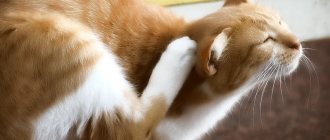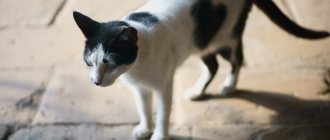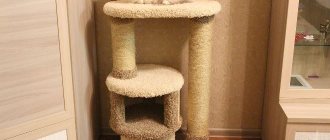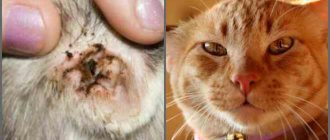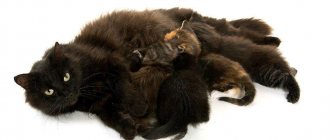What to do in case of emergency?
- Remain calm and assess the situation for any additional threats to you or your pet.
- Keep the cat as calm as possible and keep its movements to a minimum, especially if it has possible trauma, broken limbs, or other neurological symptoms.
- Contact veterinary help, inform them of the situation and obtain first aid instructions.
- To transport your cat safely, use a suitable container or carrier for cats (it is best to remove the lid of the container to avoid accidentally injuring the cat through a small door or opening). Cover the cat with a towel or blanket. Also use some type of cloth (towel) to stabilize the animal's neck and spine.
- Take your cat to the clinic as quickly as possible, but use reasonable caution!
What can you do to warm your cat's paws?
First of all, you should determine the cat's base body temperature. If your cat's paws remain cold despite their normal readings, then you should try to warm them up. You need to determine how warm the cat is in the room where she is. This can be done by monitoring your pet's behavior:
- The cat can walk on the floor or selectively move on the top. In the second case, we can conclude that the floor is not warm enough for the cat. After all, the higher you go, the warmer the air.
- If there is a sudden cold snap and the cat shed the day before, this may cause her paws to become cold. After all, it is not the fur that warms the cat, but the undercoat.
- You can observe when a cat persistently asks to go to bed with its owner. This indicates that the pet is looking for additional sources of heat.
The most optimal action in this case would be to insulate the cat’s house with a warm substrate. Now they have begun to propose doing this with heat-insulating fabric. Outwardly, it is not very presentable, but the cat will be warm and comfortable in such a house. When a cat sleeps in its house, its heat output is increased. If her home is cold, she may freeze in her sleep.
colds in cats - causes, symptoms and treatment
What signs will help determine the onset of the disease?
In addition to the signs listed above, the kitten also exhibits other symptoms indicating the onset of the disease. These include:
- increasing or decreasing the number of trips to the toilet;
- diarrhea or bloody stools;
- vomit;
- increased anxiety of the animal;
- hair loss;
- increased thirst;
- cardiopalmus;
- deep breathing;
- nasal discharge.
If you have these symptoms, you should consult a specialist; only he can make a correct diagnosis and prescribe treatment. You should not self-medicate, as this will only worsen the situation.
Often a kitten's dry nose is an indicator of intestinal problems, namely the presence of hair in the gastrointestinal tract. This is the only indicator of this problem.
A cat has a hot nose - reasons
If you find a hot nose on your cat, do not rush to panic. Probably the reason for this was something from this list:
- the cat has recently woken up
- during sleep and immediately after, her nose remains warm and dry for some time; - the cat has experienced stress or has been actively playing
- a general increase in body temperature against this background also leads to a warming of the nose; - There is dry air in the room
- this problem is especially pressing in winter, when heating radiators are running, as well as in summer, when the air temperature is very high.
If the cat has no other signs of illness or illness, the condition of its mucous membrane and the outer surface of the nose will most likely return to normal after a short time. What does it mean if a cat has a hot nose for a long period of time (2-3 hours): there is probably a pathogenic bacillus in its body. In this case, pay close attention to see if your cat has any of the following signs, and if so, it’s time to see a veterinarian:
- refusal to eat, loss of appetite, or vice versa – insatiable appetite and thirst;
- high body temperature (above 40°C);
- dyspnea;
- runny nose, cough;
- vomiting, constipation, diarrhea;
- change in fur color, hair loss;
- drowsiness, apathy, anxiety, aggressiveness.
Hot nose in a cat after giving birth
Childbirth for a cat, like for a person, is a stressful situation. On the day the contractions begin, the cat becomes restless, walks around the room a lot, periodically trying on the prepared place - the “nest”. At the same time, the rectal temperature decreases by a couple of degrees. As the pain intensifies, her pulse and breathing rate increase. It is quite expected that a cat's initially cool or warm nose will gradually become hot. After labor is over, she will need some time to recover, after which the temperature of her body, nose and ears will return to normal.
If something went wrong during the birth of the kittens, there was an infection in the uterus or you see excessive bloody discharge, most likely her nose will be dry. In this case, a hot nose in a giving birth cat will indicate a general rise in temperature due to inflammatory or other painful processes in the body. To help her, you will need to contact a specialist.
The cat has a hot nose and is sneezing
Colds do not bypass our furry friends. Dry mucous membranes are not able to trap pathogens that penetrate the nasal passages, causing a response - sneezing. When a cat has a warm nose and is sneezing and snorting, he most likely has developed a cold. Additional symptoms are decreased activity and appetite, and a general increase in body temperature. Although sometimes sneezing is a sign of a foreign body getting into the nose. Or it could be a symptom of an allergy, such as to the chemicals you use when cleaning.
The cat is lethargic, the nose is dry and hot
Cats, like people, can freeze during a walk during the cold season or simply catch a cold in a draft. If you see that the cat has a hot and dry nose, he himself has become lethargic and apathetic, his appetite has decreased, this indicates the presence of a cold, viral or infectious disease. A competent veterinarian will be able to more accurately determine the disease and prescribe treatment.
What does it mean if a cat has a hot nose and diarrhea?
The cat is shaking with small tremors and a hot nose
When a cat has a warm nose (and even hot) and this is accompanied by trembling, the following conditions may be the cause:
Often, heavy breathing in cats, as in people, is associated with inflammation of the mucous membrane inside the nose and narrowing of the nasal passages. This happens with colds. There are other cases when heavy breathing is accompanied by the fact that the cat has a hot and dry nose, what does this mean:
- the animal probably has heart problems or pleurisy;
- perhaps the cat is simply scared, he is stressed, accompanied by a rapid heartbeat and rapid breathing;
- changes in breathing may be associated with overheating or hypothermia of the cat;
- in the presence of infections and viruses, diseases of internal organs, difficulty breathing becomes one of the indirect signs;
- with various injuries, especially if the chest is damaged, the animal’s breathing causes pain, it becomes heavy and uneven.
The cat has a hot nose and paws
We have thoroughly dealt with the question of why a cat has a warm nose. However, sometimes owners notice that their pet has hot paw pads and begin to panic. If we remember that cats have the only uncovered part of their body are their paws, and that their body temperature is normally 1-2 degrees higher than that of a human, then we can assume that in most cases the fears and fears of the owners are not well founded. It’s another matter if the animal’s general body temperature is higher than normal. Take a closer look at other symptoms of illness and, if necessary, contact a veterinarian.
Why does the cat have hot ears and nose?
When a cat has a warm, wet nose in combination with hot ears and this is not associated with banal overheating or stress, one of the following diseases can be suspected:
- inflammation;
- infection;
- gastrointestinal disease;
Reduction of dislocation in hospital
A caring owner, when his pet is injured, is first puzzled by the question of how to treat the dislocation. Treatment of dislocations in cats can be conservative (closed) or surgical (open).
Conservative reduction of a dislocation is performed under general anesthesia, as this procedure is very painful. In addition to sleeping pills, the animal is given medications that relax the muscles.
After the joint is returned to its original position, the limb is fixed with a splint or bandage. The animal must wear it for 10 days. After the dislocation has been reduced, the cat must undergo a rehabilitation period, during which the owner will follow the doctor’s instructions and recommendations.
The animal's physical activity during the recovery period should be moderate. The duration of rehabilitation depends on the severity of the injury.
For reference! To check the success of the procedure, the reduced limb is flexed and extended, moved to the side and a control x-ray is taken.
Tail dislocation
The tail gives the cat grace, serves as a kind of balancing device and is an extension of the spine. A cat can dislocate its tail in a fight or when hit by a car.
Even the most caring owner can accidentally injure a cat by stepping on its tail or pinching it in a door. Externally, a dislocated tail appears crooked.
We invite you to familiarize yourself with 9 dangerous diseases for humans that are carried by cats.
His mobility decreases, the cat experiences pain.
How to keep a cat warm
Frozen paws are not scary, but they are uncomfortable. Often cats, in search of warmth, climb into the owner’s bed or stay close to the radiators. Make your pet’s own “heater”: buy an insulated house. An alternative option is to strengthen an ordinary den with heat-insulating material. The home will not look very attractive, but the cat will like it. During sleep, your pet's heat transfer increases, so without a house it can freeze.
Are there any tips for holding and handling an injured cat?
Most animals in an emergency will be disoriented and possibly panicked. Severe stress and panic in your pet can turn a friendly animal into an aggressive one. Although most anxious cats respond well to a soothing voice and head and shoulder rubs, be careful when approaching or touching an injured animal.
- Putting a muzzle on a cat can be a difficult task, as the shapes of cats' faces vary greatly. There are special muzzles designed for cats, but they rarely fit and are uncomfortable to put on, especially if there is an emergency. For some cats, a makeshift muzzle consisting of a pair of tights wrapped around the head and tied with a piece of string is suitable. This muzzle will prevent any possible bites. If the muzzle option is not suitable for you, then use a simple towel to provide at least some degree of protection.
- You can wrap a frightened or uncontrollable cat's body in a bag or towel. Do not compress the trachea or airway. If possible, leave the cat's head free, but if the cat is very aggressive, it will be safer to wrap it entirely. You should NOT wrap your cat if you suspect any fractures or spinal injuries.
- If you suspect that your cat has a back injury, restrain it with straps or ropes. Pay special attention to immobilizing the head and neck. To transport a cat, it is best to use a large box.
How to identify a hip dislocation
The hip joint in a cat is quite simple, but despite this, it is the strongest and most mobile. Dislocation of the hip joint (dislocation of the femoral head) is a relative displacement of the femur relative to the pelvis, accompanied by rupture of the round ligament and overstretching of the joint capsule.
An animal that has damaged the hip joint cannot step on the affected limb, which, as a rule, becomes shortened.
Attention! Dislocation of the femoral head is one of the most severe.
What does it look like
Failure of the hind limbs is easy to notice, but there are cases when the animal prefers to lie down for several days and refuse to eat or drink. As a rule, the cat still gets up to go to the toilet. At this point, changes in gait can be seen. In the early stages, disorders may look like this:
- an unsteady gait that looks like you've lost your balance;
- severe wobbling of the back of the body;
- the hind legs move apart;
- after a few steps the cat sits down, doing this many times until the path is completed;
- the animal drags its legs along the floor without lifting them off the ground.
Worsening usually occurs very quickly, but if the owner manages to contact a veterinary clinic at an early stage, then treatment will have a greater chance of success.
What is the normal state of the animal?
Domestic cats and dogs living in city apartments have very sensitive paws throughout their lives. Cats that are used to walking a lot in the open air, and even more so those living in the yard or even homeless animals, have paws that are little susceptible to both cold and heat. As the pads of their limbs hardened, the nerve endings became more resilient. Therefore, the temperature of the paws of cats living outside and at home is slightly different to the touch.
However, the normal temperature of the paws is cooler than the body. However, they must be warmer than the environment, even if the cat walks in the snow.
While sleeping, your cat's paws become hotter. Because in a state of complete rest, when the animal lies down and all the muscles relax, the immune system works powerfully. And this, in turn, affects the overall body temperature of the animal, increasing it. Cats sleep 18 hours a day. Sleep gives way to drowsiness - this is a state when the mind is active and the body is relaxed. At this moment, the paws become a little cooler.
What are the normal paws of a cat?
It is quite difficult to answer this question with utmost accuracy, since the cat’s body temperature also changes during the day. This is a completely normal physiological scene. Domestic cats have soft paw pads with good sensitivity. The yard scratch has rougher pads. This causes low vulnerability of nerve endings to the outside temperature.
If we compare the temperature numbers of the pads with the temperature of the rest of the body, then they are somewhat further than on its surface. But at the same time they are higher than the outside air temperature. A similar picture is observed almost all day long. After all, most of the day (18 hours) cats sleep or doze.
We invite you to read: What can make chickens and chicks sick at home?
You should not equate sleep with napping, during which the animal simply rests. But in a state of sleep, the cat’s device relaxes as much as possible. At this time, one can observe the primacy of the processes of inhibition of higher nervous activity, a significant decrease in metabolic processes against the background of activation of the immune system.
It is known that immunity can influence the basic body temperature. This explains that in a dream there is some increase in it. This phenomenon fits within the physiological norm.
Important! If the cat's temperature decreases not only in its paws, but also in its entire body, this is a reason to contact a veterinarian. There can be quite a lot of reasons for this and only a doctor can determine it.
Is it normal for a cat to have cold paws?
Often, owners do not pay attention to the temperature of their pet’s paws.
Does your cat have cold paws? But this can be an important sign of the animal’s distress, especially if this symptom manifests itself for quite a long time. Of course, you shouldn’t worry about why your cat has cold paws and assume the worst. If the tips of your cat's paws are constantly getting cold, you should first understand the cause of this condition. This will help prevent negative consequences in the future.
© shutterstock
At a doctor’s appointment, the cat’s owner will most likely remember when, what and how his beloved cat ate, when and how much water he drank, but at what time his paws began to become cold is unlikely. The veterinarian should be provided with detailed information, which is why it is necessary to monitor your pet carefully.
You need to know that in cats, body temperature changes quite seriously over 24 hours. The amplitude can be more than one degree. Therefore, it is difficult to track exactly when a cat’s paw pads became colder than usual. Nevertheless, it is worth trying, diagnosis and help depend on it.
What types of dislocations exist in cats?
With any type of dislocation, the cat experiences severe pain.
Depending on the time when the cat received the dislocation, injuries vary:
- fresh or recent, which were received less than 3 days ago;
- not fresh – the dislocation occurred about 2 weeks ago;
- neglected - the animal was injured more than 3 weeks ago.
Dislocation in a cat can be complete or incomplete:
- In case of complete dislocation, the ends of the bones forming the joint do not touch each other; in case of incomplete dislocation, they do.
- Incomplete dislocation is also called subluxation.
Dislocation can be simple, when the soft tissues and skin remain intact, or complex. A complex dislocation is accompanied by rupture of ligaments and tendons, and fractures inside the joints.
Operation for advanced cases
Surgery is necessary for advanced or complex dislocations.
After receiving an injury, the dislocation must be corrected as soon as possible. Delay in receiving medical help leads to muscle contraction, the formation of a dense blood clot and scar tissue. These changes make it difficult to reduce the dislocation using a closed method. In such cases, the question arises about surgical treatment of advanced dislocations.
During the operation, during which the animal is asleep, an incision is made in the joint area, through which fibrin clots and destroyed parts of the joint are removed. The joint returns to its original position; this will require force or special levers. A joint reduced openly also requires fixation and temporary immobilization.
Sometimes a cat requires surgical fixation of a joint:
- for dislocations of the hip or wrist joints, it is carried out using special pins;
- for elbow and ankle - screws and wires.
Congenital dislocations in furry pets are usually eliminated using the open method. After a minor dislocation, the animal recovers within 3-4 days. The cat can use its paw, but has a slight limp. Full recovery from severe dislocations takes about 3-4 weeks.
Where does the SCD come from?
Possible reasons:
- disturbance of cerebral blood supply - a change in the circulatory system of the brain due to hypoxia caused by heart disease, hypertension, anemia, impaired blood clotting, the formation of small hemorrhages near blood vessels, arteriosclerosis
- tissue damage from free radicals As cells age, they process nutrients less and less well, the amount of energy decreases, and the number of free radicals in the cells increases, which the body’s antioxidant defense does not have time to neutralize. An excess of these radicals leads to tissue damage, with brain tissue being especially sensitive.
Predisposing factors
The thermoregulation function is vital for all living organisms, including cats. Healthy, full-fledged animals do not need to carefully monitor the temperature of their paws. But older individuals and kittens need observation. Because their thermoregulation is weakened due to age and condition of the body. Therefore they need special care.
Viral infections are the most common cause of leukopenia in cats. Feline immunodeficiency virus (FIV) and feline infectious peritonitis (FIP) are the most dangerous in this regard. Their peculiarity is that infectious agents can penetrate into the leukocytes themselves, where they successfully reproduce and destroy protective cells.
Of course, the number of the latter is sharply decreasing. Other causes of leukopenia may include:
- Bacterial infections. Moreover, this cause refers to almost everything: from abscesses to sepsis.
- Any inflammation causes a decrease in the number of leukocytes (and neutrophils in particular) if it has become chronic.
- All types of bone marrow diseases, including severe injuries, poisoning, exposure to radioactive materials.
- Pancreatitis. Inflammation of the pancreas will “pull” white blood cells from the bloodstream, which over time will lead to leukopenia.
- Certain medications. Corticosteroids, used to treat arthritis and other inflammatory pathologies, suppress the production of white blood cells when used long-term. As a rule, the pathology in this case is reversible.
- Stress. Long-term stress leads to many negative consequences for the body, including disruption of the bone marrow.
We suggest you familiarize yourself with Cat rash on stomach
What are the signs that require contacting a veterinarian?
If the following symptoms are detected in a kitten, you should consult a veterinarian to identify the causes of your pet’s illness:
- malaise, lethargy, apathy;
- dry and hot nose;
- cold and pale nose;
- change in organ color (blue, yellowish, red, white).
The owner should know that a pale and cold organ in a kitten is a sign of:
- chronic illness;
- hypothermia;
- stress;
- low body temperature;
- poisoning;
- complete lack of appetite.
A white and warm nose is a sign of a disruption in the kitten’s circulatory system. The blue and hot organ talks about:
- heart failure;
- inflammation of the respiratory organs;
- oxygen starvation.
When a kitten has a hot and red organ, this is a sign:
- infectious disease;
- rhinitis;
- mechanical damage.
If a kitten has a hot, dry nose and warm ears, then this is not necessarily a sign of illness, because heat exchange has not yet been established in babies, and their body temperature is higher than that of an adult pet. This may be due to the work of the body and its protection from hypothermia.
Causes of no concern
The animal body, that is, the human body, is characterized by the presence of thermoregulation. Suitable at a very young age. Ant. its imperfection cannot be observed, and in older cats its function is weakened. During periods of scale, it normally functions in a way that cannot be helped. Measures to correct it are usually not required.
The temperature indicators are also affected by the microclimate of the room in which the beloved is located. If it is cold where the cat is, then the temperature of its paws will drop.
Important! Breeds of cats whose pycnidia are devoid of hair cannot effectively protect the processes of normal thermoregulation. Where the cat is in its natural environment, in life) there are no negative temperatures. Therefore, such cats in a warm apartment need some kind of clothing.
Maybe the situation is the opposite. Excessive heat in the room and intense physical activity can cause the cat's paw pads to become cold. To this day this is understandable. The fact is that between the toes and paws of a cat there are sweat glands. Simply put, the bitch sweats due to her paws. Intense sweat leads to cooling of the pads.
If an animal has long hair, this phenomenon will only go away unnoticed. Sweat settles on the fur and does not cause cooling.
Possible ailments
Cold extremities can indicate a number of ailments that may occur slowly or even unnoticeably. To compile an anamnesis, you need to observe your pet for 3-4 days, recording changes in the temperature of the paws.
Cooling of the extremities after or after use for other purposes is considered an absolutely normal phenomenon. Narcosis is a drug and the body is in a state of severe intoxication. Reduced body temperature protects the brain from the harmful effects of the chemical components of the drug. Even in the summer, after anesthesia, it is recommended to keep the cat on a heating pad until it comes to its senses and goes to a cooler place.
For any cat owner, the health of their beloved pet always comes first. At any slight hint of malaise, the owner becomes worried and worried. After all, animals cannot tell what and where it hurts, even if they feel very bad. The first thing everyone without exception does when they suspect something is to touch the noses of their cats.
Sensitive owners always closely monitor the behavior of animals. And this is correct, since behavior is a direct indication of well-being. And if the nose is hot, and the cat is lethargic, refuses to eat, does not want to play, and lies down most of the time, this is already a reason to be seriously wary. If, with a hot nose, the fluffy is cheerful, cheerful, playful, and demonstrates an excellent appetite, you can relax. Why do cats have hot ears? In what cases is this the norm, and in what cases is it a dangerous signal. Any owner needs to clearly define this.
If a cat's hind legs fail, the cause can only be pathological. It occurs as a result of disorders of the cardiovascular system, the functionality of the brain and the musculoskeletal system.
Intervertebral hernia is the cause of osteochondrosis, which manifests itself in cats after the age of eight. During this period, active aging of the body begins, leading to a decrease in the functionality of the musculoskeletal system. As a result, a protrusion of the intervertebral disc forms between the vertebral bodies.
Mobility device
If a cat loses its hind legs, the pathology is accompanied by the following symptoms:
- acute pain, due to which the cat constantly meows, becomes weak, lethargic, and moves little;
- periodic formation of involuntary muscle tone and tension;
- in the affected areas of the body, mobility is reduced or absent;
- poor appetite, the cat may completely refuse to eat;
- possible dyspeptic disorders, symptoms of ulcers or pancreatitis;
- the body has a characteristic pose, the animal moves strangely, and can only use its front legs to do this.
Inflammation of the spinal cord most often occurs due to the penetration of a bacterial infection or viral agent. Initially, the pathogen spreads through the blood-brain barrier, as it is small in size. It enters the brain, through which it penetrates into the cerebrospinal fluid.
READ Causes of increased salivation in cats
Acute inflammation occurs, accompanied by the following symptoms:
- the animal constantly feels sick, vomits at any time, regardless of food intake;
- unsteady gait;
- acute pain throughout the body, the animal lies down and is unable to move;
- behavior changes, the pet may be overly aggressive and not recognize its owners;
- Gradually, due to refusal of food, the body becomes depleted; without antibacterial therapy, the pet dies.
Important! Diseases of the central nervous system and peripheral nervous system are dangerous and rarely result in recovery. They are difficult to suspect in the early period, so the veterinarian often has to treat complications.
If the animal's blood vessels are prone to developing an inflammatory reaction or the blood coagulation system is overactive, blood clots may form. They come in large and small sizes. Even a slightly small blood clot can cause harm by clogging a capillary. If large blood clots form, they are able to resist the blood flow of the largest arteries that supply blood to the spine and lower extremities.
The cat's hind limbs may be paralyzed. Symptoms develop instantly:
- hind legs drag along the floor;
- the animal becomes restless, its behavior changes sharply;
- The forelimbs may gradually fail, leading to complete paralysis.
You can save your pet only by urgently contacting a veterinarian. But in most cases there is not enough time.
The pathological process occurs in kittens immediately after birth. The condition is characterized by the following symptoms:
- the hind legs are not able to hold on, they move apart;
- when walking, the cat may drag its legs;
- Without help, the problem does not go away, but gets worse.
The cause of the pathology is the incorrect formation of the hip joint. If a cat has a multiple pregnancy, with more than 5 kittens, this is fraught with their low mobility in the uterus. If the hip joints do not move, they develop incorrectly.
Tick paralysis
If the owner of a cat periodically walks him outside, he should be wary of the spring and summer periods. At this time, ticks actively reproduce and bite cats and dogs. Not all ticks carry the infection, but some of them transmit toxins into the blood, causing neurological disorders.
Hip dysplasia in a kitten
Tick-borne encephalitis or meningitis leads to inflammation of the brain, neurological reactions, which cause severe paralysis. The condition is aggravated by profuse vomiting, a sharp increase in body temperature, and complete refusal to eat.
As toxins spread through the blood, internal organ failure occurs, with a gradual loss of functionality. The animal dies without the use of medications against tick toxins.
Stroke
Stroke in a cat can be of the following types:
- ischemic – narrowing of the vessel wall with the development of hypoxia and necrosis of brain tissue;
- hemorrhagic - damage to the wall of a cerebral vessel with the formation of hemorrhage.
If the part of the central nervous system responsible for the lower extremities is damaged, initially the legs begin to braid, then their function is completely disabled. It is possible to repair such damage in rare cases.
Spinal injuries
Cats generally love heights. But this often leads to them falling, resulting in spinal damage. If the lower area is damaged, the hind legs immediately fail. It is impossible to do anything about this condition. The doctor may try to make a special device for the cat, thanks to which it can move on its front legs.
Cardiomyopathy
All organs function thanks to normal blood supply. To deliver blood, normal functioning of the myocardium of the heart muscle is necessary. If an animal develops cardiomyopathy, this section does not function sufficiently. As a result, it is difficult for blood to be delivered to the lower extremities. First, the cat begins to drag its legs, then cannot move with them.
Thanks to the intake of vitamins and microelements, a certain metabolism is formed in the cat’s body. With its help, the cellular composition is updated, the functionality of absolutely all cells occurs.
Vitamin deficiency is a condition of a sharp decrease in all types of vitamins. This is typical for pets that are fed monotonous food that does not contain nutrients. As a result, general weakness occurs and the legs become weak when walking. A common occurrence is the development of seizures, that is, muscle twitching.
Important! If a cat develops kidney failure, its filtration capacity is impaired. All substances are actively released from the body without being absorbed back. Therefore, the same reactions occur as with vitamin deficiency.
This is a disease accompanied by the sudden formation of blood clots that block an area of the spinal cord. If the area in the lumbar region is affected, it is the hind legs that stop functioning. The cat is unable to walk. The condition is accompanied by severe pain, so she begins to scream.
Brain inflammation
Not only the spinal cord can become inflamed, but also the brain. This condition is called encephalitis, meningitis. Most often it develops against the background of viruses and infections. They damage neurons, causing an acute inflammatory reaction.
Cerebral edema develops with the following clinical condition:
- sudden and profuse vomiting begins;
- the legs give way, the cat falls, unable to rise;
- body temperature rises;
- if the respiratory center is involved in the process, the pet is not able to breathe.
If the condition develops in a kitten, its immune system is not able to cope with the condition. He quickly dies. Adults have a better chance of surviving with timely treatment.
Hyperparathyroidism
Hyperparathyroidism is a disease of the parathyroid gland that causes increased secretion of parathyroid hormone. As a result, the metabolism of calcium and phosphorus accelerates and the function of the musculoskeletal system is disrupted. Bone mass decreases, resulting in increased fragility and decreased functionality. Both the front and hind legs may be amputated.
Symptoms of a dislocation in a cat - how to recognize
A dislocation is the displacement of bones relative to each other without damaging them. By shifting from their anatomical position, bones can damage soft tissue, adjacent tendons, blood vessels and ligaments.
A dislocated limb looks unnatural.
You can recognize a dislocation in a pet by the following symptoms:
- with a congenital dislocation, the animal is lame on one leg;
- with a traumatic dislocation, the cat cannot fully lean on the surface;
- The pet experiences pain from touching the damaged area;
- Not only the gait changes, but also the behavior of the animal: sleep becomes restless, the cat tries to lick the site of the dislocation;
- The dislocated part of the body is usually asymmetrical. A dislocation may be indicated by its unnatural position, the protruding part of the displaced bone;
- With a complex dislocation, ruptures and hematomas are observed in the damaged area.
Symptoms of fever in cats and kittens
But if the thermometer shows over 39.5°C, while the cat has hot ears and a dry nose, there is cause for alarm, especially if there are symptoms such as:
- the cat refuses food and water;
- general lethargy, drowsiness;
- the cat's ears are hot, red, swollen, with an unpleasant odor;
- hides from the light, from hands, behaves inappropriately;
- the cat’s nose is hot and dry, with dried purulent crusts;
- signs of a cold (sneezing, coughing, runny nose, eyes).
In this case, there can be only one explanation why the cat is hot - there is an inflammatory process in the body.
Cats have hot ears for other reasons:
- head and ear trauma,
- infectious or viral disease;
The cat is cold. The cat is cold. Why is the kitten cold?
Cats are quite frost-resistant animals. Long-haired breeds can withstand frosts down to minus 30 degrees. If the cat is cold at room temperature, then there is cause for concern.
The consequences of lowering the temperature can be irreversible and even lead to death.
If your cat is cold, look for the following signs:
- the animal lies down in a warm place;
- chills, trembling;
- lethargy;
- pallor of the mucous membranes.
If these signs appear, take your pet's temperature. If it is below 36 degrees, the cat is cold in the abdominal area, you need to contact a veterinarian, otherwise the animal may fall into a coma.
- bleeding;
- diseases of the cardiovascular and nervous systems;
- viral or infectious diseases;
- general weakening of the body.
